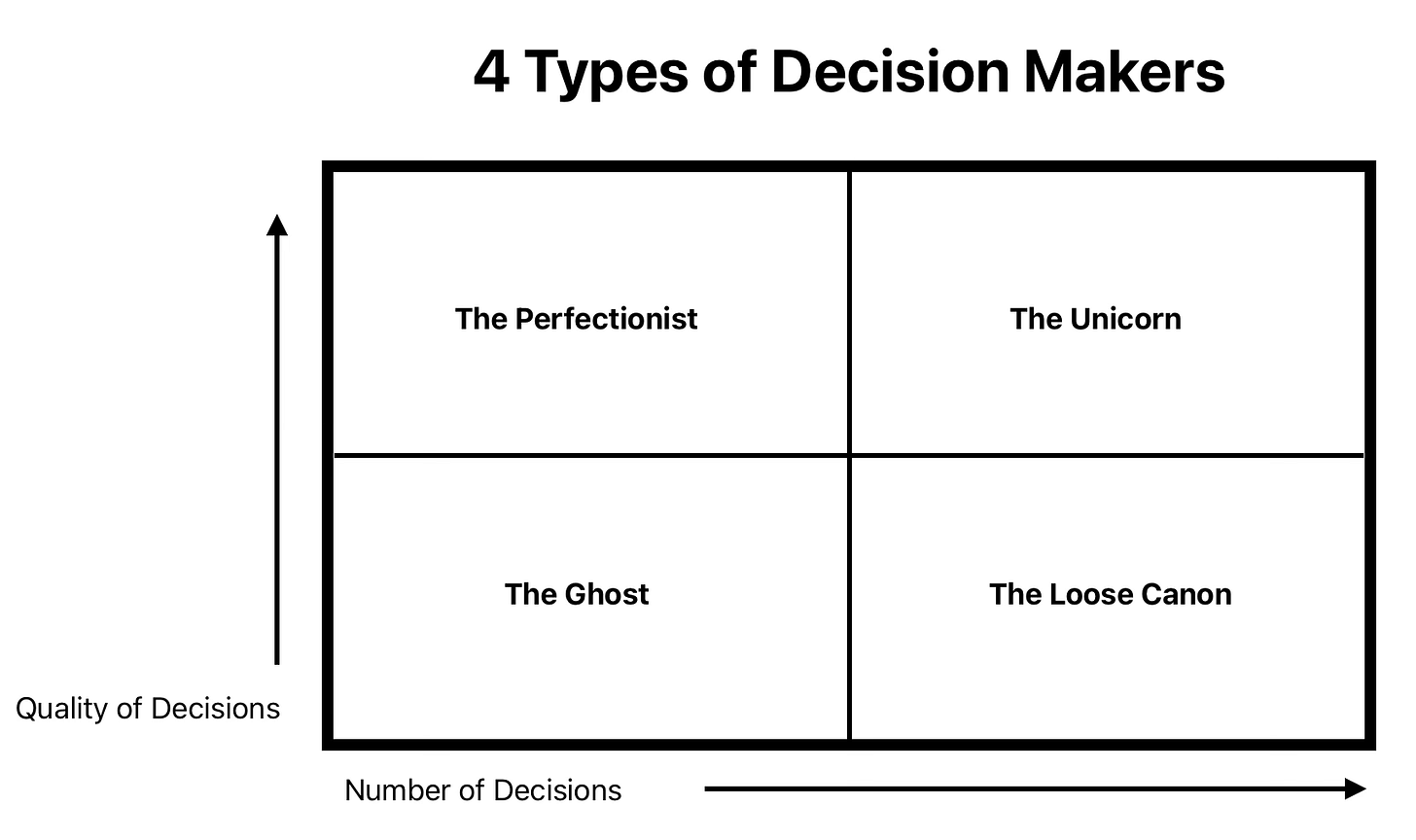The Four Types of Decision Makers
Why Your Leadership Style Matters More Than You Think

Leadership isn't what most people think it is.
Scroll through LinkedIn or pick up the latest business bestseller, and you'll find endless praise for charismatic speakers, social media savants, and magnetic personalities. These qualities might look impressive on camera, but they mask what truly separates exceptional leaders from the rest:
Their ability to make consistently good decisions at the right velocity.
The Hidden Math of Leadership Impact
Throughout my career working with dozens of leaders across different organizations, I've observed that leadership effectiveness can be distilled into a simple equation:
Impact = Number of Decisions × Impact per Decision × Decision Accuracy
This isn't abstract theory—it's a practical framework that explains why some leaders create exponential value while others merely occupy space. Within this framework, four distinct decision-making archetypes emerge, each with dramatically different results.
The Four Decision-Making Archetypes
1. The Ghost
We've all worked with them—leaders perpetually "gathering more information" or "waiting for the right time." Their calendar might be packed with meetings, but actual decisions are virtually non-existent.
The Ghost's impact equation:
Number of Decisions: Near zero
Impact per Decision: Irrelevant
Decision Accuracy: Unknown
Net Result: Organizational paralysis and missed opportunities
Real-world example: The executive who spent six months "evaluating options" for a critical product launch while competitors captured the market.
2. The Loose Cannon
Picture a leader who treats every day like it's a crisis. They make decisions rapidly and constantly—"Move fast and break things" isn't just their motto, it's their only setting.
The Loose Cannon’s impact equation:
Number of Decisions: Astronomical
Impact per Decision: Potentially very high
Decision Accuracy: Abysmal
Net Result: Chaos with occasional transformative brilliance
Real-world example: The startup founder who launched seven different products in a single year, burning through investor cash but eventually stumbling upon a billion-dollar idea.
3. The Perfectionist
These leaders approach every decision with extreme caution. Their decisions are usually right, but by the time they make them, the opportunity has often passed. They prioritize precision while the market rewards speed.
The Perfectionist’s impact equation:
Number of Decisions: Low
Impact per Decision: High
Decision Accuracy: Excellent
Net Result: Reliable but frustratingly slow progress
Real-world example: The meticulous product manager who consistently delivers flawless products—six months after the market window has closed.
4. The Unicorn
The rarest breed. These leaders combine the decisiveness of the Loose Cannon with the accuracy of the Perfectionist, all while maintaining high velocity. They're not perfect, but they deliver exceptional leadership impact.
The Unicorn’s impact equation:
Number of Decisions: High
Impact per Decision: High
Decision Accuracy: Very Good
Net Result: Exponential growth
Real-world example: The healthcare leader who rapidly pivoted her organization to digital messaging early in a market shift, making a series of quick but well-calculated decisions that positioned the company ahead of competitors while maintaining quality of care.
The Growth Path: Evolving Your Decision-Making Style
Here's the good news: these archetypes aren't permanent. With self-awareness and deliberate practice, most leaders can level up their decision-making profile as well the decision-making profiles of their team.
The Ghost → The Perfectionist
Most organizational members start as Ghosts, often due to imposter syndrome or lack of clear role definition. When people don't understand their decision-making boundaries or fear being judged harshly for mistakes, they default to indecision. The key transformation comes through building decision-making confidence via small, low-stakes choices that provide quick feedback.
Transformation strategy: Create psychological safety and clear decision-making boundaries. Clarify exactly which decisions fall within their authority. Consider moving them into positions where decisions affect narrower outcomes with more defined parameters. Establish decision deadlines and celebrate when they're met, regardless of outcome.
The Perfectionist → The Unicorn
Perfectionists have the hardest but most promising growth path. Their accuracy is an asset, but their velocity needs work.
Transformation strategy: Introduce the concept of "reversible vs. irreversible" decisions. Help them see that 80% of business decisions are easily reversed, making "good enough now" far superior to "perfect later." Set clear decision deadlines and hold them accountable. Work with them to break big decisions into smaller, sequential choices. Actively celebrate faster decision-making, not just accurate outcomes.
The Loose Cannon → The Innovation Engine
Here's a controversial take: don't try to "fix" your Loose Cannons—channel them. These natural experimenters can become innovation powerhouses when properly directed.
Transformation strategy: Create bounded spaces for experimentation where their creativity thrives but organizational risk is contained. A Loose Cannon who lands one breakthrough in twenty attempts can deliver extraordinary value.
The Unicorn → The Super Unicorn
If you're lucky enough to work with a Unicorn, focus on helping them increase their impact per decision. They've mastered velocity and accuracy—now it's about placing them in roles with higher organizational leverage.
Transformation strategy: Move them into positions where their decisions affect broader outcomes. Create systems that free them from lower-impact decisions and expose them to the organization's most consequential choices. Consider structural changes that expand their sphere of influence across multiple teams or divisions.
The Bottom Line
Leadership isn't about charisma, charm, or looking good on quarterly earnings calls. It's about making good decisions consistently and quickly. Understanding these four archetypes can help you develop better leaders and build more effective organizations.



Very insightful and important. An invitation to look inside and learn what your style is, and how you want to grow.